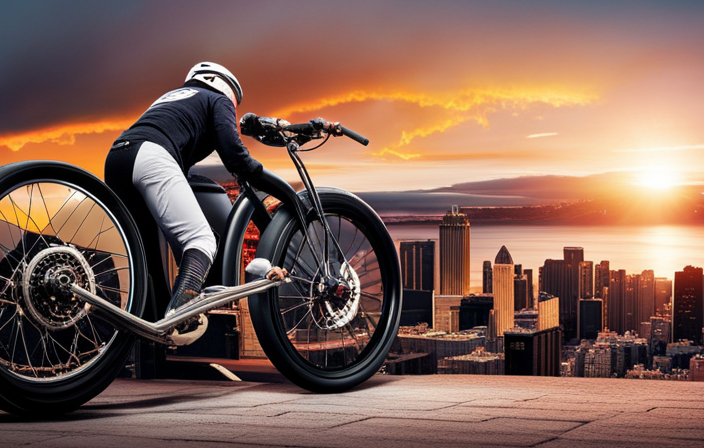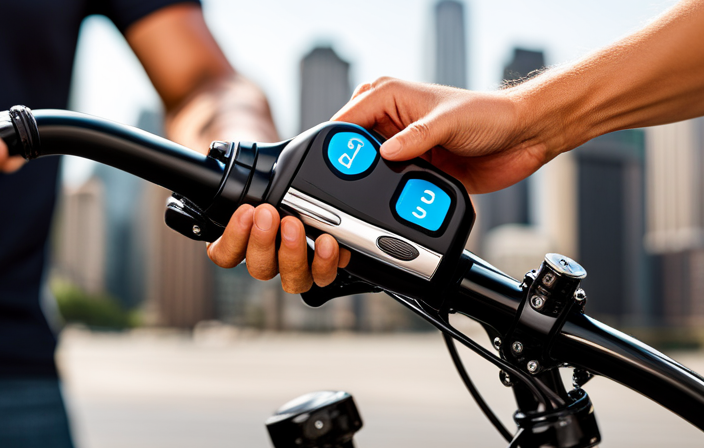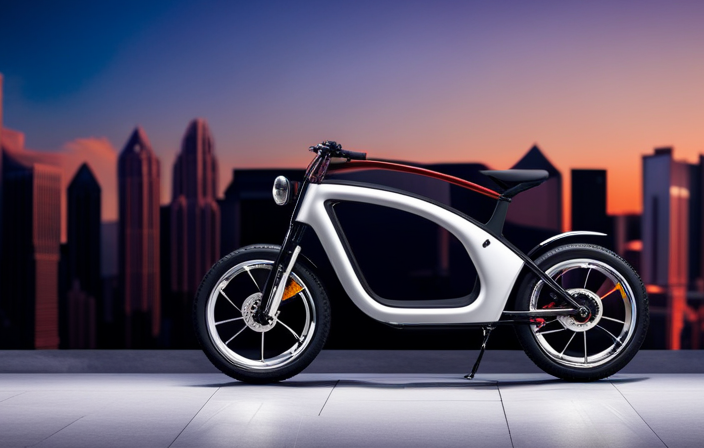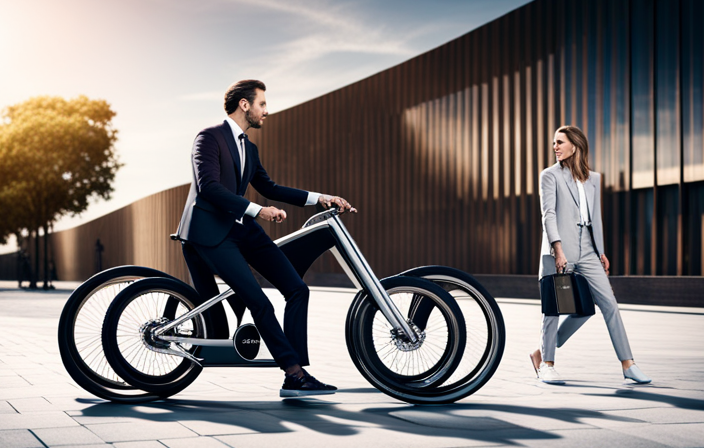As an avid electric bike enthusiast, I’ve experienced the frustration of a overheating fuse firsthand. It’s like a ticking time bomb, waiting to disrupt your ride.
In this article, we’ll delve into the various factors that can cause a 48 volt 500 watt electric bike fuse to overheat. From overloading the electrical system to faulty wiring and inadequate ventilation, we’ll explore the technical details and provide troubleshooting tips to ensure a smooth and safe ride.
Let’s dive in and unravel the mysteries behind this fiery problem.
Key Takeaways
- Overloading the electrical system by exceeding power capacity or using incorrect fuses can cause a 48 volt 500 watt electric bike fuse to overheat.
- Faulty wiring or connections, such as loose or damaged wires, can lead to electrical resistance and heat buildup in the fuse.
- Excessive heat or temperature, especially due to prolonged use, high ambient temperatures, or inadequate cooling mechanisms, can damage the electrical system and cause the fuse to overheat.
- Using an inadequate fuse size or rating, either too small or with a lower rating, can result in insufficient protection and potential overheating of the 48 volt 500 watt electric bike fuse.
Understanding the Basics of Electric Bike Fuses
Understanding the basics of electric bike fuses can help prevent overheating issues. Electric bike fuse types vary, but the most common ones are blade fuses and glass tube fuses.
Blade fuses are the most popular because they are easy to replace and can handle higher currents. Glass tube fuses, on the other hand, are more fragile and require special tools to replace.
It is important to know the common fuse overheating symptoms, such as a blown fuse, flickering lights, or a burning smell. These symptoms indicate that the fuse is not functioning properly and may be overheating.
Overloading the Electric Bike’s Electrical System
To prevent overloading your e-bike’s electrical system, make sure you don’t exceed the maximum power capacity. Here are some safety precautions for electric bike fuse replacement:
-
Disconnect the power source: Before replacing the fuse, ensure that the e-bike is turned off and unplugged from any power source to avoid electric shock.
-
Identify the correct fuse: Refer to the owner’s manual or consult a professional to determine the appropriate fuse type and rating for your electric bike.
-
Replace the fuse: Carefully remove the blown fuse and replace it with a new one of the same rating. Make sure it is securely seated in the fuse holder.
-
Test the system: After replacing the fuse, turn on the e-bike and check if the electrical system is functioning properly.
Exceeding the maximum power capacity or using incorrect fuses can lead to overheating and potential damage to your electric bike. However, another common cause for electrical system issues is faulty wiring or connections.
Faulty Wiring or Connections
Check for loose or damaged wires and connections on your e-bike to ensure a stable and reliable electrical system. Faulty wiring or loose connections can lead to a variety of issues, including overheating and potential damage to your e-bike’s electrical components.
To prevent this, regularly inspect your e-bike’s wiring and connections. Look for any signs of wear or damage to wire insulation, such as frayed or exposed wires. Additionally, make sure all connections are secure and tight. Loose connections can cause electrical resistance, leading to increased heat buildup.
If you discover any loose or damaged wires or connections, it is important to address them promptly to avoid further problems.
Now, let’s move on to the next section about excessive heat or temperature and its impact on your e-bike’s electrical system.
Excessive Heat or Temperature
Excessive heat can lead to damage and potential malfunctions in your e-bike’s electrical system. So it’s crucial to monitor and address any issues promptly.
When it comes to e-bikes, thermal management is essential for maintaining optimal performance and preventing overheating. Excessive heat can be caused by various factors, such as prolonged use, high ambient temperatures, or inadequate cooling mechanisms.
It’s important to ensure that your e-bike is equipped with proper heat dissipation methods, such as heat sinks or fans, to regulate temperature effectively. Regular maintenance and inspections can help identify any potential heat-related issues and address them before they escalate.
Inadequate Fuse Size or Rating
Make sure you choose the correct fuse size and rating for your e-bike to prevent potential issues with electrical malfunctions. Inadequate fuse protection or improper fuse installation can lead to serious problems.
If the fuse is too small or has a rating lower than what your e-bike requires, it may not be able to handle the electrical load and will overheat. This can result in a blown fuse or, even worse, damage to the electrical components of your e-bike. To avoid this, consult the manufacturer’s specifications or seek professional advice to determine the appropriate fuse size and rating for your e-bike.
By ensuring the proper fuse protection, you can minimize the risk of overheating and electrical malfunctions.
Now, let’s move on to another potential cause of issues with e-bike electrical systems: corrosion or moisture damage.
Corrosion or Moisture Damage
To prevent corrosion or moisture damage in your e-bike’s electrical system, it’s important to regularly inspect and clean the components. Corrosion prevention is vital because it can lead to the deterioration of electrical connections, resulting in poor performance or even complete failure of your e-bike.
Moisture damage prevention is equally important as it can cause short circuits or electrical faults. Moisture can seep into the electrical components, disrupting the flow of electricity and potentially damaging the sensitive circuitry.
Regularly inspecting and cleaning the electrical system will help eliminate any accumulated dirt, grime, or moisture, ensuring optimal performance and longevity of your e-bike.
Moving forward, let’s now delve into the potential risks associated with short circuits or electrical faults.
Short Circuits or Electrical Faults
When it comes to short circuits or electrical faults, it’s important to be aware of the potential risks they can pose to your e-bike’s electrical system.
One crucial component that helps protect your bike’s electrical system from damage is the fuse. Electric bike fuse design plays a critical role in preventing fuse overheating. Fuses are designed to break the circuit in case of a short circuit or overload, thereby preventing excessive current flow and potential damage.
It’s essential to ensure that the fuse rating matches the requirements of your e-bike’s electrical system to avoid overheating. Regularly inspecting the fuse for any signs of damage or wear is also important.
By taking these precautions, you can minimize the risk of short circuits or electrical faults that could potentially damage your e-bike’s electrical system.
Overcharging the battery, on the other hand, can lead to a whole different set of problems.
Overcharging the Battery
Overcharging the battery can result in a variety of issues for your e-bike’s electrical system. It is important to understand proper battery maintenance and charging habits to avoid these problems.
When you overcharge the battery, you are subjecting it to excessive voltage and current, which can lead to overheating and damage. This can shorten the overall lifespan of the battery and decrease its performance over time.
To prevent overcharging, it is crucial to follow the manufacturer’s recommendations for charging duration and use a charger specifically designed for your e-bike’s battery. Additionally, it is advisable to avoid leaving the battery connected to the charger for extended periods when it is already fully charged.
By being mindful of your battery maintenance and charging habits, you can ensure the longevity and optimal performance of your e-bike’s electrical system.
To avoid any further issues while using the electric bike in extreme conditions, it is important to take certain precautions.
Using the Electric Bike in Extreme Conditions
Using the e-bike in extreme conditions can have detrimental effects on its performance and longevity. When pushing the limits of an electric bike, it is important to consider safety considerations and the impact it may have on the bike’s overall performance. Here are three key factors to keep in mind:
-
Temperature: Extreme heat or cold can affect the battery’s efficiency and lifespan. High temperatures can cause the battery to overheat, leading to reduced performance and potential damage. Conversely, extremely cold temperatures can decrease battery capacity and overall power output.
-
Terrain: Riding on challenging terrains such as steep hills or rough trails can put additional strain on the electric bike’s components. Excessive stress on the motor, battery, and other parts can lead to increased wear and tear, affecting the bike’s performance in the long run.
-
Moisture and Dust: Exposure to water, rain, or dusty environments can cause corrosion and damage to the electrical components of the bike. It is essential to protect the bike from these elements to maintain its performance and longevity.
Considering these factors and taking necessary precautions can help ensure optimal electric bike performance and longevity. However, poor maintenance and neglect can also have a negative impact on the bike’s overall condition.
Poor Maintenance and Neglect
Neglecting regular maintenance on the e-bike can lead to a decline in its overall performance and lifespan. To keep your electric bike running smoothly, it is important to follow some maintenance tips and avoid common mistakes.
First, make sure to clean your e-bike regularly, removing any dirt, dust, or debris that may accumulate. Additionally, check the tire pressure and adjust it accordingly to ensure optimal performance.
Another common mistake to avoid is neglecting the battery. Regularly charge and maintain the battery to prolong its lifespan.
Finally, don’t forget to inspect the brakes, gears, and chain for any signs of wear or damage. By following these maintenance tips and avoiding common mistakes, you can ensure that your e-bike will continue to perform at its best.
Speaking of performance, a faulty or defective fuse can also affect the overall functioning of your e-bike.
Faulty or Defective Fuse
After discussing the importance of proper maintenance and neglect in the previous subtopic, it is now time to delve into the issue of a faulty or defective fuse as a potential cause of overheating in a 48 volt 500 watt electric bike. A faulty fuse can disrupt the flow of electrical current, leading to increased resistance and subsequent overheating. Here are some signs that indicate a faulty fuse:
- Frequent blown fuses: If the fuse keeps blowing repeatedly, it is a clear indication of a problem.
- Burnt or melted appearance: Physically inspect the fuse for any signs of discoloration, melting, or charring.
- Electrical malfunctions: If your electric bike experiences intermittent power loss or strange electrical behavior, it could be due to a faulty fuse.
- Overheating: In extreme cases, a faulty fuse may become hot to the touch.
Identifying these signs early on can help prevent further damage to the electric bike.
Now, let’s explore the next subtopic: insufficient ventilation or cooling.
Insufficient Ventilation or Cooling
Insufficient ventilation or cooling can lead to further damage to the electric bike. When the components of the electric bike, such as the motor and battery, generate heat during operation, it is crucial for the heat to be effectively dissipated to prevent overheating. Ventilation issues and cooling problems can impede this heat dissipation process, causing the temperature to rise beyond safe levels. This can result in various negative consequences, including damage to the fuse. To illustrate the importance of proper ventilation and cooling, consider the following table:
| Ventilation Issues | Cooling Problems |
|---|---|
| Clogged air vents | Inadequate cooling system |
| Enclosed battery compartment | Insufficient airflow |
| Dust or debris buildup | Lack of heat sinks |
Neglecting ventilation or cooling can lead to the fuse overheating and potentially causing other components to malfunction. It is therefore crucial to address any ventilation or cooling issues promptly to ensure the longevity and optimal performance of the electric bike. Moving forward, it is essential to explore the potential problems that can arise from incompatible or low-quality components.
Incompatible or Low-Quality Components
When using incompatible or low-quality components, you run the risk of compromising the performance and durability of your electric bike. One important aspect to consider is the electric bike fuse compatibility.
The fuse is a crucial safety component that protects the electrical system from excessive current flow. Using a fuse that is not compatible with the electric bike’s voltage and wattage can lead to overheating and potentially cause a malfunction or even a fire.
Similarly, low-quality components can have a negative impact on the overall performance and reliability of the electric bike. It is essential to invest in high-quality components that are specifically designed for electric bikes to ensure optimal functionality and safety. Neglecting this can result in frequent breakdowns and costly repairs.
Transitioning into the next section, it’s also important to avoid overusing or abusing the electric bike.
Overusing or Abusing the Electric Bike
Using an electric bike excessively or mistreating it can lead to premature wear and tear, reducing its lifespan. To ensure optimal performance and longevity of your electric bike, proper usage and maintenance are essential. Here are some key points to consider:
- Regularly clean and lubricate the chain to prevent dirt buildup and improve efficiency.
- Avoid riding the bike in extreme weather conditions, as excessive heat or cold can affect the battery performance.
- Always charge the battery using the provided charger and follow the recommended charging time to prevent overcharging or undercharging.
- Pay attention to weight limits specified by the manufacturer to prevent unnecessary strain on the motor and other components.
- Be mindful of the terrain and adjust the power assist level accordingly to prevent excessive strain on the motor and battery.
By following these guidelines, you can maximize the lifespan of your electric bike and minimize the need for repairs.
Now, let’s delve into troubleshooting and preventing fuse overheating issues.
Troubleshooting and Preventing Fuse Overheating Issues
To troubleshoot and prevent fuse overheating issues, it’s important to regularly check the electrical connections and ensure they are secure. Loose or damaged connections can cause resistance and increased heat, leading to fuse failure.
Additionally, it is crucial to inspect the fuse itself for signs of damage or wear. If the fuse appears burnt or melted, it should be replaced immediately.
Another common cause of fuse overheating is overloading the circuit. Make sure the fuse rating matches the electrical load and avoid connecting too many devices at once. Utilizing a fuse with a higher amp rating may seem like a quick fix, but it can lead to more serious problems, such as wire damage or even fires.
Frequently Asked Questions
Can a 48 volt 500 watt electric bike fuse overheat due to using the bike in extreme weather conditions?
Extreme weather conditions can cause an electric bike fuse to overheat. The quality of components in an electric bike can also impact fuse overheating. It is important to ensure high-quality components for better fuse performance.
How can I prevent fuse overheating in my electric bike?
To prevent fuse overheating in my electric bike, I should follow these electric bike fuse maintenance tips: 1) Regularly inspect the fuse for any signs of damage. 2) Ensure proper wiring connections. 3) Avoid overloading the circuit. 4) Keep the bike in a well-ventilated area.
Is it possible for a faulty or defective fuse to cause overheating?
Yes, a faulty or defective fuse can cause overheating in an electric bike. Voltage fluctuations can also impact fuse overheating. The capacity of the fuse plays a crucial role in preventing overheating.
Can using low-quality components in the electric bike lead to fuse overheating?
Using low-quality components in an electric bike can lead to overheating of the fuse. Improper maintenance can also reduce the lifespan of the fuse. Voltage fluctuations can further contribute to fuse overheating.
What are some common signs that indicate a fuse is overheating in an electric bike?
One common sign of a fuse overheating in an electric bike is a burning smell coming from the fuse box. To troubleshoot the issue, check for melted or discolored fuses and ensure proper ventilation for the bike’s electrical components.
Conclusion
In conclusion, when it comes to the overheating of a 48 volt 500 watt electric bike fuse, it is crucial to consider various factors.
From overloading the electrical system to faulty wiring or connections, there are many elements that can contribute to this issue. It is important to ensure that the fuse size and rating are adequate, and that there is sufficient ventilation and cooling in place.
Moreover, using high-quality components and avoiding overuse or abuse of the electric bike can help prevent fuse overheating problems.
By addressing these factors, you can ensure a smoother and safer ride on your electric bike.









